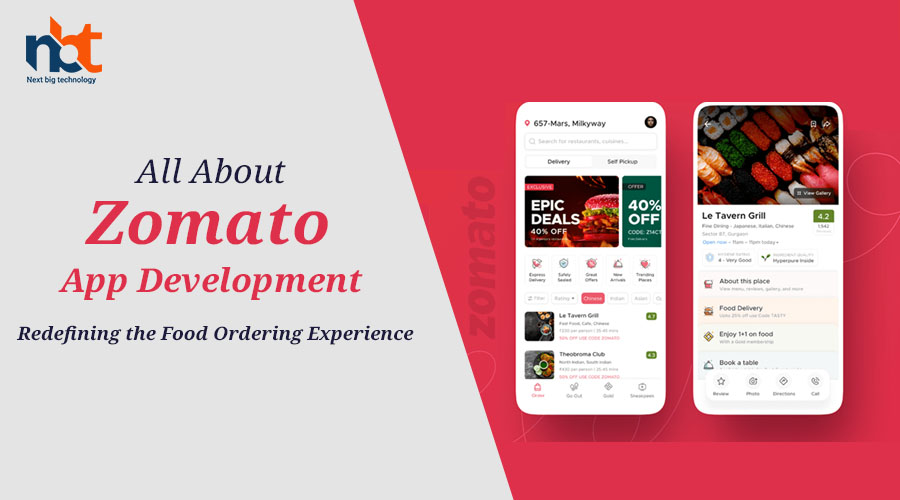Introduction:
Zomato, one of the leading food delivery platforms globally, has transformed the way people order food. With its extensive restaurant network, user-friendly interface, and innovative features, Zomato has become a go-to app for food enthusiasts. If you’re interested in developing your own food delivery app like Zomato, this comprehensive guide is for you. In this guide, we will explore the key features of the Zomato app, the technology stack required, and the step-by-step process to develop a Zomato-like app. Let’s dive in and redefine the food ordering experience!
I. Understanding Zomato App Development:
- Overview of Zomato:
- Zomato is a popular online food delivery platform that connects users with local restaurants. It offers a wide range of features, including restaurant discovery, menu browsing, ordering, and delivery tracking.
- Key Features of the Zomato App:
- Restaurant Discovery: Zomato allows users to discover nearby restaurants based on their location, preferences, and filters such as cuisine, ratings, and price range.
- Menu Browsing and Reviews: Users can browse menus, view food photos, read restaurant reviews, and make informed decisions about their orders.
- Seamless Ordering: Zomato enables users to place food orders from their favorite restaurants with just a few taps. Users can customize their orders, specify delivery instructions, and view order summaries.
- Real-Time Tracking: Zomato offers real-time tracking of food deliveries, allowing users to monitor the progress of their orders and receive updates on estimated delivery times.
- Multiple Payment Options: The app supports various payment options, including credit/debit cards, digital wallets, and cash on delivery.
- Ratings and Reviews: Users can rate and review restaurants, helping others make informed decisions about where to order from.
- Loyalty Programs: Zomato offers loyalty programs where users can earn rewards and discounts based on their orders and engagement with the app.
- Customer Support: The app provides customer support channels to address any issues or concerns users may have during the ordering and delivery process.
II. Technology Stack for Zomato App Development:
- Front-End Development:
- Native iOS Development: Swift programming language, Xcode IDE, UIKit framework.
- Native Android Development: Java or Kotlin programming language, Android Studio IDE, Android SDK.
- Back-End Development:
- Server-Side Language: Node.js or Python for server-side development.
- Web Framework: Express.js or Django for building APIs and handling server-side logic.
- Database: MongoDB or PostgreSQL for data storage.
- Cloud Services: Amazon Web Services (AWS) or Google Cloud Platform (GCP) for hosting and scalability.
- APIs and Integrations:
- Geolocation APIs: Integration with geolocation services like Google Maps to provide location-based features such as restaurant discovery and delivery tracking.
- Payment Gateway Integration: Integration with secure payment gateways like Stripe or PayPal to facilitate seamless and secure transactions.
- SMS Gateway Integration: Integration with SMS gateways to send order confirmations, delivery updates, and verification codes.
- Restaurant Management APIs: Integration with restaurant management platforms to sync menus, receive order notifications, and manage inventory.
III. Steps to Develop a Zomato-Like App:
- Define Your App’s Objectives:
- Determine the primary goals and target audience for your food delivery app. Identify the unique features or differentiating factors that will set your app apart from Zomato.
- UI/UX Design:
- Create wireframes and design mockups for your app’s user interface and user experience. Focus on intuitive navigation, visually appealing layouts, and seamless interactions.
- Front-End Development:
- Develop the front-end of your app using the chosen technology stack. Implement core features such as restaurant discovery, menu browsing, ordering, and real-time tracking.
- Back-End Development:
- Set up the server-side infrastructure using the chosen programming language and web framework. Implement the necessary APIs and services for user authentication, order management, and integration with restaurant partners.
- Geolocation and Restaurant Data:
- Integrate geolocation services to enable restaurant discovery based on user location. Utilize APIs or databases to populate your app with restaurant data, including menus, images, and reviews.
- Payment Integration:
- Integrate a secure payment gateway to enable users to make seamless transactions within the app. Ensure compliance with industry standards for data security.
- Order Management and Tracking:
- Develop a robust order management system to handle order processing, notifications, and real-time tracking. Implement features like order history and order status updates.
- Ratings and Reviews:
- Implement a system for users to rate and review restaurants, helping others make informed decisions. Allow users to provide feedback and report any issues they encounter.
- Loyalty Programs:
- Design and implement a loyalty program to reward users for their engagement and loyalty. Offer incentives such as discounts, exclusive offers, and personalized recommendations.
- Testing and Quality Assurance:
- Conduct comprehensive testing to ensure the app’s functionality, performance, and user experience. Test on various devices, screen sizes, and operating systems to ensure compatibility.
- Deployment and Launch:
- Deploy your app to the respective app stores (App Store and Google Play Store) and make it available for users to download and install. Promote your app through digital marketing channels and leverage social media platforms to reach your target audience.
IV. Conclusion:
Developing a food delivery app like Zomato requires careful planning, design, and implementation. By following the steps outlined in this guide and leveraging the appropriate technology stack, you can create a seamless and user-friendly app that connects food lovers with their favorite restaurants. Remember to focus on user-centric design, efficient ordering and delivery processes, secure payment processing, and reliable customer support to provide a delightful food delivery experience. Embrace the power of Zomato app development and satisfy the cravings of millions of users worldwide.

















